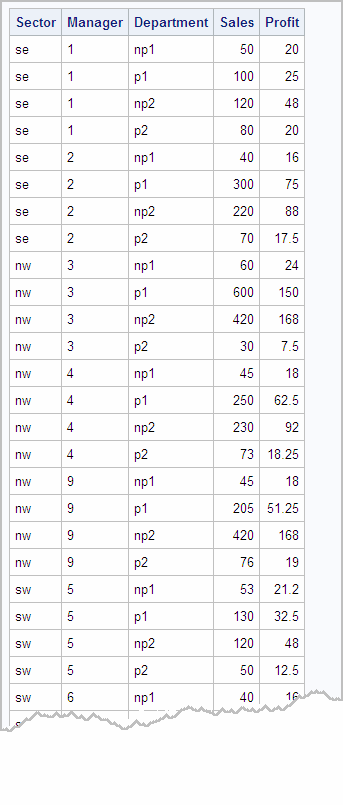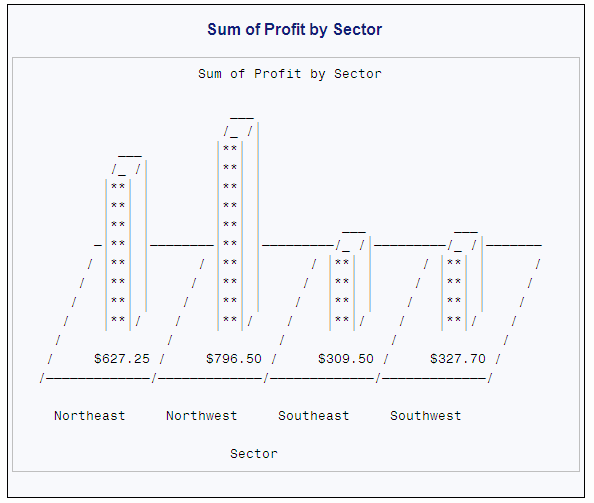REPORT Procedure
- Syntax

- Overview
- Concepts
- Using
- Results
- Examples
 Selecting Variables for a ReportOrdering the Rows in a ReportUsing Aliases to Obtain Multiple Statistics for the Same VariableConsolidating Multiple Observations into One Row of a ReportCreating a Column for Each Value of a VariableDisplaying Multiple Statistics for One VariableStoring and Reusing a Report DefinitionCondensing a Report into Multiple PanelsWriting a Customized Summary on Each PageCalculating PercentagesHow PROC REPORT Handles Missing ValuesCreating and Processing an Output Data SetStoring Computed Variables as Part of a Data SetUsing a Format to Create GroupsSpecifying Style Elements for ODS Output in the PROC REPORT StatementSpecifying Style Elements for ODS Output in Multiple StatementsUsing Multilabel FormatsUsing the WIDTH= and CELLWIDTH= Style Attributes with PROC REPORT
Selecting Variables for a ReportOrdering the Rows in a ReportUsing Aliases to Obtain Multiple Statistics for the Same VariableConsolidating Multiple Observations into One Row of a ReportCreating a Column for Each Value of a VariableDisplaying Multiple Statistics for One VariableStoring and Reusing a Report DefinitionCondensing a Report into Multiple PanelsWriting a Customized Summary on Each PageCalculating PercentagesHow PROC REPORT Handles Missing ValuesCreating and Processing an Output Data SetStoring Computed Variables as Part of a Data SetUsing a Format to Create GroupsSpecifying Style Elements for ODS Output in the PROC REPORT StatementSpecifying Style Elements for ODS Output in Multiple StatementsUsing Multilabel FormatsUsing the WIDTH= and CELLWIDTH= Style Attributes with PROC REPORT
Example 13: Storing Computed Variables as Part of a Data Set
| Features: |
PROC REPORT statement options: OUT= COMPUTE statement: with a computed variable as report-item DEFINE statement options: COMPUTED |
| Other features: |
CHART procedure |
| Data set: | GROCERY |
| Format: | $SCTRFMT |
Program That Creates the Output Data Set
libname proclib
'SAS-library';
options fmtsearch=(proclib);
title;
proc report data=grocery nowd out=profit;
column sector manager department sales Profit;
define profit / computed;
/* Compute values for Profit. */
compute profit;
if department='np1' or department='np2' then profit=0.4*sales.sum;
else profit=0.25*sales.sum;
endcomp;
run;Program Description
Specify the format search library.The SAS system option FMTSEARCH= adds the SAS library
PROCLIB to the search path that is used to locate formats.
Specify the report options. The
NOWD option runs PROC REPORT without the REPORT window and sends its
output to the open output destinations. OUT= creates the output data
set PROFIT.
Specify the report columns. The
report contains columns for Manager, Department, Sales, and Profit,
which is not in the input data set. Because the purpose of this report
is to generate an output data set to use in another procedure, the
report layout simply uses the default usage for all the data set variables
to list all the observations. DEFINE statements for the data set variables
are unnecessary.
Define the computed column. The
COMPUTED option tells PROC REPORT that Profit is defined in a compute
block somewhere in the PROC REPORT step.
Calculate the computed column. Profit
is computed as a percentage of Sales. For nonperishable items, the
profit is 40% of the sale price. For perishable items the profit is
25%. Notice that in the compute block, you must reference the variable
Sales with a compound name (Sales.sum) that identifies both the variable
and the statistic that you calculate with it.
The Output Data Set
Program That Uses the Output Data Set
options fmtsearch=(proclib);
proc chart data=profit; block sector / sumvar=profit; format sector $sctrfmt.; format profit dollar7.2; title 'Sum of Profit by Sector'; run;
Program Description
Specify the format search library.The SAS system option FMTSEARCH= adds the SAS library
PROCLIB to the search path that is used to locate formats.

